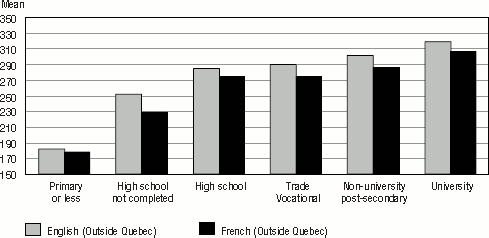
Figure 3.2
Source: International Adult Literacy Survey, 1994; International Adult Literacy and Skills Survey, 2003.
Outside Quebec, however, the situation is different (Figure 3.2). There are significant differences in the prose literacy performance of Francophones compared to Anglophones with the same level of educational attainment. With the exception of those with elementary education or less, significant differences are observed at each level of educational attainment. Further investigation of this issue will be the subject of future research.1
Reliable data on the literacy performance of Aboriginal people have been scarce until now. While IALSS data are not representative of the total Aboriginal population in Canada, the IALSS survey presents a unique opportunity to examine the literacy, numeracy and problem solving proficiency of a portion of the Aboriginal population.
The IALSS targeted Aboriginal people living in urban areas in Manitoba and Saskatchewan, and Aboriginal people living in selected communities in the territories (covering a majority of the populated areas). In all other areas, Aboriginal people were not specially targeted. Thus, this section describes the literacy, numeracy and problem solving scores of the Aboriginal population aged 16 and over living in urban Manitoba and urban Saskatchewan, in the Northwest Territories and the Yukon Territory, as well as the Inuit population in Nunavut (See Text Box A3).